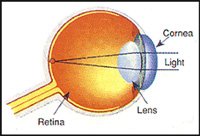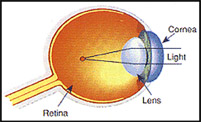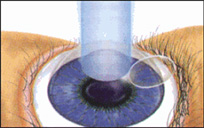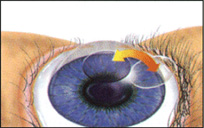|
Laser Surgery
|
|
What is LASIK?
Laser In-Situ Keratomileusis (LASIK) is a vision correction procedure which corrects two of the most common vision problems -
nearsightedness, farsightedness, and astigmatism - by reshaping the front of the eye.
LASIK combines the precision of the excimer laser with the 30-year history of lamellar keratoplasty (ALK) to give the patient
with severe nearsightedness and astigmatism an opportunity to become less dependent upon glasses or contact lenses.
Nearsightedness and Astigmatism
More than 70 million people in North America are nearsighted. The medical term is myopia.
Many of those who are nearsighted also suffer from a condition called astigmatism.
If you are nearsighted, it means you can see "near" objects clearly, but objects farther away are blurry. Astigmatism causes
images to appear distorted.
The following diagrams show how a normal eye works and what causes nearsightedness and astigmatism to occur.
Normal Eye

|
In a normal eye, light rays flow through the cornea and lens and focus directly on the retina, producing clear vision.
|
Nearsighted or Myopic Eye

|
In nearsightedness, or myopia, the eye is too long or the cornea is too steep. Light rays focus in front of the retina causing distant objects to be blurry.
|
Astigmatic Eye

|
In an astigmatic eye, the cornea is irregularly shaped. This causes light rays to focus on several places, producing distorted images.
|
|
|
The Solution
In addition to glasses or contact lenses, low to mild degrees of nearsightedness and astigmatism can be corrected with refractive
procedures, including radial keratotomy (RK), photorefractive keratectomy (PRK), and astigmatic keratotomy (AK).
The LASIK procedure was developed to treat more severe degrees of nearsightedness and astigmatism.
Drs. Becker and Dzwieleski can advise you which, if any, of the procedures might be right for you.
The excimer laser, which is used in LASIK to reshape the cornea, was approved by the U.S. Food and Drug Administration in October
1995 for widespread use in the United States. LASIK has been used for several years in other parts of the world. More than
50,000 people have undergone the procedure.
How is LASIK done?
For thoses whose vision problems may be too extreme for PRK or RK, LASIK may be the answer.
As with PRK, LASIK is usually performed on one eye at a time. You will be seated in a chair similar to the ones used in a
dentist's office. You will receive a local anesthetic in the form of eye drops.
LASIK improves the curvature of the cornea by reshaping the inner layers of tissue with the laser instead of reshaping the outer
surface, as with PRK.
The following diagrams show how the surgery is accomplished:

|
First, a microkeratome is used to fold back the top layer of the cornea, creating a flap. Then, the beam from an excimer laser removes microscopic inner layers of corneal tissue to reshape the eye and improve the way light is focused by the eye.
|

|
Following the laser treatment, the flap is closed to complete the procedure.
|
|
|
What happens after the procedure?
Most patients report no discomfort following LASIK. Others say there is some discomfort, which usually lasts from 12 to 24 hours.
Vision may also be blurry at first, but this blurring should clear up in a few days.
The visual recovery is generally faster than with PRK. This usually allows both eyes to be treated within days of each other.
It is important to keep follow-up appointments with your doctor to make sure your eyes are healing properly and to measure your
visual progress.
What are the risks and benefits?
As with any surgical procedure, there are some risks as well as benefits. Since LASIK involves the inner layers of corneal
tissue, it is a more precise procedure for the surgeon to perform than PRK.
But, also because LASIK involves the inner layers of tissue, there is a reduced risk of complications with post-operative pain,
infection and hazy cornea, which are experienced by a small percentage of PRK patients.
The results of LASIK are more rapid and more dramatic than with any other refractive procedure.
Ask the eye doctor.
If you would like to know more about LASIK, talk to the doctors at Family Eye Care, they will explain the procedure, its
benefits, possible complications and alternatives.
Because everyone's vision care needs are unique to them, only in consultation with your doctor and after a comprehensive eye
examination can you determine if you would benefit from LASIK.
|
Dr. Frank Dzwieleski •
Dr. Matthew Corso •
Optometrists
|
|
|








